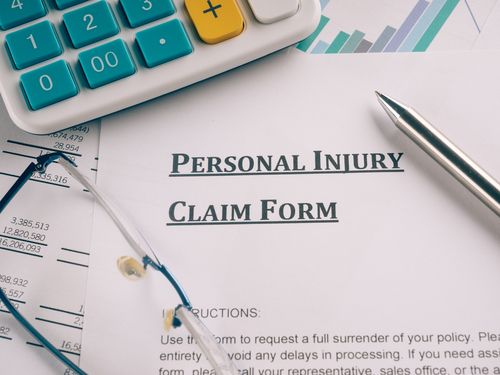The term “personal injury” refers to a wide variety of injuries including auto accidents, dog bites, slip and fall, product defects, and more. Each personal injury case is different depending on the type of injury and the circumstances surrounding it. That said, there is no “one size fits all” way to handle each claim, but there is a general process to follow. Below we will discuss the general steps of a personal injury claim and weigh the benefits of hiring an attorney and settling out of court.

Review the Insurance Policy to see if the Incident is Covered
If you believe that someone else might legally be responsible for your injury, it is a good idea to find out whether the at-fault party has insurance coverage. For auto accidents, you may check if the other driver has insurance coverage AND if your insurance plan has under- or un-insured coverage. If you are injured in a premise liability case (slip and fall, etc), it is best to collect information on the owner of the property and what, if any, insurance coverage they may have.
Insurance coverage will determine whether an injured plaintiff would be able to collect a damages award. Even if the party is at fault and found liable, if there is no money to collect the reward on, an injured plaintiff will not be made whole.
Hire an Attorney
The next step following an injury is to discuss your case with a personal injury attorney. Many personal injury attorneys will be willing to have an initial consultation free of charge where you can discuss the merits of the case with you. You will also get a better idea of what your legal options are.
Most personal injury attorneys work on a contingency. This means the client will pay nothing unless a settlement or judgment is rendered in the client’s favor. The client and attorney will agree upon a percentage of the settlement or judgement as a fee for services rendered. Whether you should or should not hire an attorney depends on the complexity of the legal issues and the facts surrounding them.
An added benefit of hiring a personal injury attorney is that the attorney and his or her team will fully handle the investigations involved in your case. That is, the attorney will gather police reports, photographs, witness statements, medical records and bills, employment and lost wages, policy limits, etc. and keep track of the statute of limitations. Without an attorney, the injured person will have to collect all this information and deal with the insurance companies alone, which can be stressful and intimidating. An injured person’s main priority should be to get healthy, without the added stress of compiling the above information and negotiating over it.
Decide on Filing a Lawsuit or Not
Most personal injury cases are settled out of court and without even filing a civil lawsuit. If the defendant has insurance, a plaintiff can file a third-party claim against the at-fault person’s insurance provider. The plaintiff’s attorney, should one be hired, will put together a demand letter to send to the insurance company. The demand letter outlines the incident that injured the plaintiff (ie., auto accident, dog bite, etc.), summarizes medical care and injuries, includes medical records and bills, sums up the medical bills, lost wages, future medical care, out of pocket expenses, etc., and discusses how the case has affected the plaintiff’s life (pain and suffering). After the demand package is sent to the insurance company, a response is typically received between thirty and forty-five days. The defense insurance can either reject the demand, accept the offer, or begin negotiations.
If no reasonable agreement comes from negotiations, it may be time to consider filing a lawsuit. This prolongs a potential settlement due to discovery, mediation, and court dates; however, it may be beneficial if the case has high value with merits and the defense insurance company is not offering any reasonable settlements. Court procedures can be costly for both parties, so sometimes it is best to avoid trial if possible. If a case has a smaller value or is lacking merits, it may be best to consult with an attorney about whether it would financially be a good decision to proceed with litigation.
Whether you decide to file a lawsuit or not, it is important to keep track of the Statute of Limitations to prevent losing any rights to compensation for your claim.
Statute of Limitations
The Statute of Limitations is a time limit on filing a personal injury case after the injury occurs. Each state has its own limit. The Statute of Limitations in California allows two years from the date of the injury for the injured party to go to court and file a lawsuit against anyone who could be at-fault. If an injured party fails to file a personal injury lawsuit within the two-year period, the court will likely refuse to hear the case and the right to compensation will be lost.
Despite the Statute of Limitations being two years in California, there are special situations that could potentially extend the deadline. There are other circumstances that affect when the “clock” runs.
For personal injury claims against a city, county, or California state government agency, there is a six-month Statute of Limitations. Claimants must adhere to a strict set of procedural rules.

Benefits of Settling the Lawsuit out of Court
While there are situations where it is more beneficial to see a case through trial, it is more often the most beneficial to settle out of court if possible. Settlements out of court tend to be quicker with less risk and fewer costs.
As mentioned above, most personal injury attorneys work on a contingency basis. The standard is typically thirty three percent for pre-litigation settlements. This percentage commonly jumps to forty percent when the claim goes into litigation. This means that the attorneys will ultimately take a higher percentage for seeing the case through trial, as litigation can be a long and stressful process. Throughout the litigation process, costs build up for filing, hiring expert witnesses, etc. The longer a case is drawn out in the trial process, the more costs will add up, and ultimately the more expensive it will be.
Cases go to trial when a plaintiff/attorney wants to argue for more money. However, trials are unpredictable and even with the best arguments put together, a plaintiff may walk away with a smaller judgment than expected or no reward at all. If the plaintiff contributed to the incident or any subsequent injuries, there is a risk that the defense insurance will argue that and be able to escape liability or minimize the judgment rendered by the court. If a reasonable settlement can be negotiated between the two parties out of court, there won’t be any questions or concerns as to whether the plaintiff will be made whole at the end of the day.
Additionally, when a case goes to trial, the details of the trial become public record. This includes testimony, evidence, any submissions by either party that frame the other side to look bad, etc. Often, private investigators are hired to follow a party and reveal any private details. For parties who wish to keep certain aspects of their lives private, settling out of court is the best option when possible.
Personal Injury Claim FAQ
Who pays in a personal injury claim?
In an ideal situation, the at-fault party (defendant) pays for the plaintiff’s award through his or her insurance. However, the defense insurance essentially reimburses the plaintiff for medical bills and out of pocket expenses at the close of the case, to the extent that the policy allows. This means that all throughout treatment, the plaintiff/injured party is paying for co-pays, medications, travel expenses, mileage, etc. Depending on the severity of the injuries and necessary medical treatment, cases could extend as long as a duration of several years without the plaintiff being reimbursed until the end, if at all.
Additionally, if a health insurance carrier pays for medical costs of the plaintiff, the carrier has a right to reimbursement following the settlement. The amount of a settlement a plaintiff ultimately ends up with can be significantly affected by the bills the plaintiff paid up front, the bills submitted to health insurance or MedPay, and bills that were deferred until settlement. You can sit down and discuss all these issues with a personal injury attorney, should you hire one.
It is also important to note that full reimbursement is not always guaranteed. If a defendant has a smaller policy and an injured party has high medical bills or serious injuries, the defense insurance adjuster may tender the full policy limits right away. At that point, the injured party can submit an under-insured motorist demand to his or her insurance. If the injured party’s policy has UIM coverage, then that policy can be used to help make the injured party whole. Not every policy has this coverage, so it is best to check with your insurance provider to find out exactly what your policy entails.
Additionally, if a plaintiff shares some level of liability, the total amount of compensation can be affected. These types of issues are typically discussed during negotiations with insurance adjusters. However, if a situation like this occurs and the case goes to court, it could potentially hurt a plaintiff’s case.
How do you calculate pain and suffering?
Pain and suffering varies from person to person. Pain and suffering are subjective. Who you are as a person and what you enjoy has a big impact on the mental side effects. Pain and suffering encompasses physical pain, emotional trauma, mental injuries such as exacerbated fear, insomnia, and anxiety, and loss of enjoyment of life.
Sometimes determining that pain and suffering is easy, for example, when you have medical records that outline what happened in detail. However, at other times, this is not so straightforward. It is best to document the journey to recovery and how it affects your life. This includes photographs, journals, out of pocket bills, etc. Where mental health has been affected, seeking help from a professional and proving treatment can help calculate pain and suffering.
The negative effects of pain and suffering are wide ranging. From lost working hours to a reduction in your quality of life, there’s a lot to consider. Some elements are easy to prove, while others require legal expertise if you are to get to the bottom of them. Using the skills of a personal injury lawyer, you can determine the true cost of your injury.
What are the chances of winning a personal injury lawsuit? What is the average payout for a personal injury claim?
The question of whether you will be successful in a personal injury lawsuit is complex and varies depending on the circumstances and merits of your individual case. According to United States government statistics, 95% of personal injury cases are settled pretrial. Of the 5% that go to trial, 90% of plaintiffs (injured party) lose the case.
According to this study, roughly 70% of people in the study received a settlement/award for their personal injury claims. This means that approximately less than 30% of people receive no settlement or award. Of the 70% that received settlements, the overall average payout was $52,000, though payouts typically range from $3,000 to $75,000 with some outliers receiving more and some receiving less.
To get a fair evaluation of your case, consider reaching out to a personal injury attorney.
Contact the team at Batta Fulkerson Law Group today to schedule a FREE one-hour consultation to review your case and available options.
What to expect in your Consultation Meeting:
- Collection of information about you to help assist you better
- Review of any court documents
- Review of what happened in your claim
- Explanation of court processes, fees, and what we can do to help your case.
(619) 333-5555 Call Today or Book Online!


